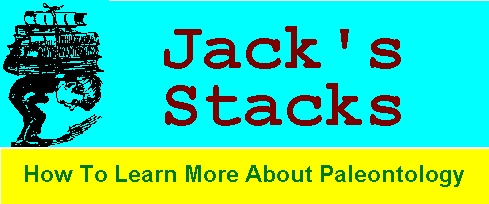
Serious Stratigraphy

I probably should have changed my title this month to "How to Learn More About Geology" since the book reviewed deals more with the rock record than the fossil record. Our subject book of the month is Interpreting the Stratigraphic Record, by Donald R. Prothero, W. H. Freeman & Company, 1990, 410 pages. This is a hard cover book retailing at $52.95.
My first comment concerning this volume is that it is for the seriously minded only. This is a text designed for a 10 to 15 week upper level undergraduate course in stratigraphy. The author states in the Preface that the book is meant to follow a course in sedimentology and that courses in physical and historical geology should also have been completed. After reading this I naturally thought, "How hard could it be?" I found out rather quickly.
Interpreting the Stratigraphic Record is divided into three main sections: Introduction, Depositional Systems, and The Rock Record. These are further subdivided into a total of fourteen chapters. Each chapter ends with a brief bibliography for further reading. The first of two appendices contains the entire 1983 North American Stratigraphic Code which details the rules and regulations for describing and naming geologic formations. The second appendix is a multi-page presentation of the Geologic Time Scale including best age estimates. The appendices precede a complete bibliography and subject index.
The introduction of some forty pages is subdivided into two chapters covering "The Concept of Geologic Time" and "Stratigraphic Data". Included here is a narrative on the historical constructions of a relative geologic time scale beginning with the thoughts of the ancient Greeks. This is followed by a description of attempts through history in establishing numerical ages for the relative time scale. Stratigraphic Data includes description of sedimentary rock types, sedimentary structures, bedforms, bedding plane structures, and biogenic (caused by living creatures) sedimentary structures.
The second main section, "Depositional Systems", consists of four chapters covering: Nonmarine Environments, Coastal Environments, Clastic Marine and Pelagic Environments, and Carbonate Environments. Probably the topics most pertinent to the local geology are the last two. These four chapters cover some 120 pages.
The last main section, 180 pages, includes eight chapters as follows: Lithostratigraphy, Lithologic Correlation, Stratigraphic Methods, Biostratigraphy, Geophysical and Geochemical correlation, Geochronology, Chronostratigraphy, and Tectonics and Sedimentation. The chapter "Biostratigraphy" contains the most reference to fossils in the book; this should be of interest locally as well since it was this discipline that was used to name the "classic" formations of our area. Other chapters explain dating and correlation using magnetic reversal records and radioactive decay. The chapter on stratigraphic methods will teach you how a stratigraphic section is measured and described.
Most of the books I review have at least a couple of things in common: I am interested in the subject matter and, I have previously read a lot of material on the subject and am familiar with it. Interpreting the Stratigraphic Record met my first criteria but I am woefully short on the second. This fact made it one of the tougher books that I've read. Speaking from my own perspective, I'll have to re-read some of the chapters again to retain and understand everything presented. But to repeat myself, you need to challenge yourself with higher level reading if you truly want to increase your knowledge.
I have probably presented enough cautions to prevent most of you from even thumbing through this book. I don't really want to do that. Check into this at the library and read some of the chapters that pertain to your interest. You may find as I did that you can pick up enough to help you understand more about the local geology. This in turn may lead you to more interest and investigation into the Cincinnatian as a whole: the fossils as once living animals, their environments, their life associations, their manner of dying and burial, the geography of their time.....the list is endless. Collecting and identifying fossils is just one phase of our hobby. For me, learning in these related areas has become just as fulfilling.